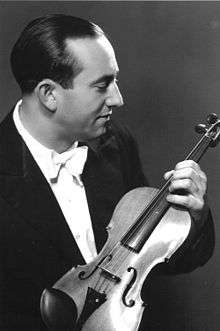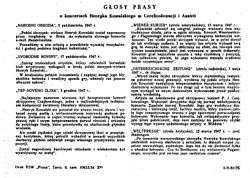Henryk Kowalski
| Henryk Kowalski | |
|---|---|
 Henryk Kowalski (Photo Linhart - Brno) | |
| Background information | |
| Birth name | Henryk Kowalski |
| Born |
July 2, 1911 Suwalki, Poland |
| Died |
January 24, 1982 (aged 70) Providence, Rhode Island, USA |
| Genres | Classical |
| Occupation(s) | Concert violinist |
| Instruments | Violin |
| Years active | 1921–1982 |
Henryk Kowalski (July 2, 1911 - January 24, 1982) was a Polish Jewish violinist and composer.
Biography
Early childhood
Kowalski learned how to play the violin at the age of four from his father, who was the conductor in a regimental orchestra. By the age of seven, he had already given many violin recitals in various Polish cities, and was widely considered to be a child prodigy. When he was ten, Kowalski appeared as a soloist with the Warsaw Philharmonic Orchestra, performing music by Niccolò Paganini. He began to study music at the Warsaw Conservatory under Professor Joseph Jarzebski—a former student of the famous Leopold Auer—and traveled to Paris to continue his studies with violinist Jacques Thibaud.
Early career
In the years leading up to the outbreak of World War II, Kowalski was noted for his performances with Polskie Radio, the national broadcasting organization. Performances he made on the radio were broadcast live across the country, and reached audiences in Germany, Czechoslovakia, Russia, and Lithuania. He was also engaged in popular music, and composed popular songs.
When war finally began in 1939, Kowalski was arrested by Germans in Węgrów while on his way to join his family in Brest-Litovsk. He managed to escape to Brest-Litovsk, which had been occupied by Soviet troops. There he met the great Russian violinist Miron Polyakin, who wrote a letter recommending him as a very talented artist. Polyakin's approval helped his admittance to the Moscow Conservatory, where he continued his studies with Abram Yampolsky, a well-known violin teacher.[1]

Hiding
Kowalski continued to perform in Soviet-occupied territory, which now included areas of Poland as a result of the Molotov-Ribbentrop Pact. In 1941, Germany launched an invasion of the Soviet Union. At the time, Kowalski was in the city of Lvov with a group of other Polish musicians, and he was again arrested. Members of the Gestapo tortured him in captivity, and he was sentenced to death. While being transported to the place of execution, Kowalski and another inmate attacked their guard and escaped. After wandering for a long time, he found refuge with a family of peasants near Drohobych, now part of modern Ukraine. He spent 20 months hiding during the day in a shelter dug under the peasants' pigsty.[2] After this long period of hiding, he joined a group of Russian partisans, with whom he remained for the rest of the war.
Post-war
At the end of the war, Kowalski traveled to Vienna, where he again took up a career as a soloist. The Austrian press hailed him as a great violinist. He was admired not only for his virtuosity, but also for his ability to perform two violin concertos in a single performance. He performed mainly with the Viennese Great Radio Symphony Orchestra, conducted by Carl Ettie.[3] Before returning to Poland, he embarked on a very successful concert tour in Czechoslovakia, and was compared by his reviewers to the most prominent violinists of the era.[4] When he arrived in Poland once again, his return was heralded by enthusiastic articles in the Polish press.[5] He began to perform again for Polskie Radio, and gave many concerts around the country.

Late career and emigration
In 1956, Kowalski was sent to the Soviet Union as part of a Russian program promoting cultural exchange with other countries. He continued to perform while in Russia with various orchestras, and received excellent reviews.[6]
In 1957, he emigrated to Israel with his wife and son. He became a violin teacher at the Music Conservatory in Haifa, but continued to tour in Israel and in Europe. The Israeli press reviewed him favorably, as the following excerpt from a review from the Jerusalem Post attests:
Today, thin spread are the God-gifted Jewish violinists who formerly grew like mushrooms from the soil...With Kowalski, Eastern Europe, once an inexhaustible reservoir, has delivered us one of the last pearls of Jewish musicians. This has been recognized in Vienna...and hopefully...this pearl will soon get the setting it deserves.
From 1962-1963, Kowalski moved with his family to the Netherlands. There, he worked for the Netherlands Radio Union Orchestra in Hilversum. After this period, he again moved to Israel, but the outbreak and aftermath of the Six Day War convinced him and his family to emigrate to the United States. In April 1971, he settled down in Providence, Rhode Island, and took up a position at the music department of Brown University as a violin instructor. He and his family received American citizenship on the 200th anniversary of the establishment of the United States, on July 15, 1976. He continued to receive recognition for his talents in America, and on February 6, 1978, he was invited with his wife and other distinguished Americans of Polish descent to the White House by President Jimmy Carter.[8]
Kowalski died suddenly due to hemorrhage of the upper intestinal tract, at the age of 70, on January 24, 1982, in Providence, Rhode Island.
Family
During WWII, Kowalski lost almost his entire family. Both of his parents, Abram and Dora, his three sisters, Lonia, Genia, and Danusia, and his brother David were all killed by German soldiers in Brest Litovsk in 1942, when the Jewish ghetto there was liquidated. Only his fourth sister Halina (a renowned cellist) and her two daughters, Lucyna and Henryka survived. Her non-Jewish husband, violinist Henryk Trzonek, was executed by Germans in Warsaw in 1943. Her younger daughter, Henryka Trzonek, is a well-known violinist, and lives in Frankfurt, Germany. She still performs in Germany and abroad.
Henryk Kowalski was married to Polish physician Stanislawa Maria Rossa, who was thirteen years his junior. According to his sister Halina, this marriage was the most fortunate event in his life, as it brought him stability, and helped heal many of the wounds left over from the war. He was a devoted father to his two sons, Henryk Mariusz and Michael Adam, and was deeply involved in their musical education.
Henryk Mariusz (b. 1956) is a neuroradiologist, who lives and practices in Greenville, NC. He is married to pediatrician Elizabeth Figueroa (b. 1957). They have three sons: Henryk Matthew (b. 1990), Jacob Marek (b. 1996), and Nicholas Andrzej (b. 1996).
Michael Adam (b. 1961) is a computer programmer and artist, who lives and works in Los Angeles, CA. He is married to Jane Kowalski (b. 1959), psychotherapist. They have two daughters, Emma Jean (b. 2008) and Abigail Sara (b. 2008).
References
- ↑ Chomiński, Józef (1964). Dictionary of Polish Musicians - T.I., A-L. Krakow: Polish Music Publishers.
- ↑ Rostel, E (1957-07-19). Israel News (67). Missing or empty
|title=(help) - ↑ For example, "Radio Wien (Osterreichische Rundfunkzeitschrift)", Heft 8 02/22/1947; Heft 18 05/03/1947; "Welt Illustrierte" No.9 03/02/1947; "Weltpresse" (British Zone) No.58 03/12/1947; "Wiener Kurier" (US Zone) No.60 03/13/1947; "Osterreische Zeitung" (Soviet Zone) 03/14/1947, 05/07/1947; "Die Steffel-Post" No.12 Vienna 1947
- ↑ "Svobodné Noviny", Brno No.243 10/17/1947, No. 285 12/07/1947; "Slovo Národa", Brno No.293 12/17/1947; "Náš Pozhlas", Brno No.45 11/9/1947; "Głos Ludu", Czeski Cieszyn No.131 11/06/1947, No.1 01/01/1948, 01/13/1948; "Tep Nového Zlína" 12/02/1947, 12/09/1947; "Rovnost" No.243 10/17/1947, No.269 11/19/1947, No.293 12/17/1947; "Prace", Prague No.291 12/14/1947; "Cin" Brno, No.293 12/17/1947; "Narodni Obroda" 10/05/1947
- ↑ "Tydzień" No.19 05/16/1948; "Radio i Świat" 05/24/1948, No.48 11/29/1953, No.41 10/10/1954, Nos.52-53 on 12/23/1956; "Słowo Ludu", Kielce No.101 04/28/1952; "Życie Radomskie" No.99 04/25/1952; "Życie Warszawy" 05/29/1954, "Express Wieczorny" No.126 05/28/1954, No.294 12/14/1956; "Słowo Powszechne" No.131 06/04/1954; "Głos Olsztyński" No.215 09/08-09/1956, No.219 09/13/1956; "Kurier Szczecinski" No.31 02/05-06/1956
- ↑ "советская культура" No.133 11/10/1956, No.135 11/15/1956; "правда" No.315 11/10/1956, No.319 11/14/1956; "правда украины" No.266 11/14/1956; "знамя комунизма" No.225 11/16/1956; "надднипрянська правда" No.230 11/21/1956
- ↑ "The Jerusalem Post" No.8837 06/16/1957; "Habroker Daily" Tel-Aviv; "Haaretz", Tel-Aviv No.11518 06/23/1957; "Nowiny Izraelskie" No.67 07/19/1957, No.72 08/02/1957; "L'Echo D'Israel" No.2947 07/27/1957, 01/27/1958; "Yedioth Hayom" No.763 12/15/1959
- ↑ "Rhode Island Herald" No.34 10/22/1971, No.39 11/26/1971, No.5 03/31/1972; "The Providence Journal" 11/10/1973, 11/12/1973; "Cranston Herald" No.5 04/26/1978
Bibliography
- Słownik muzyków polskich T. 1, A-Ł/ red. nacz. Józef Chomiński; oprac. Elżbieta Dziębowska [et al.]; Instytut Sztuki Polskiej Akademii Nauk – hasło: Henryk Kowalski, Wyd. Polskie Wydawnictwo Muzyczne, Kraków 1964
- "Aria na wiolonczelę", 'Aria for Cello' by Włodzimierz Kusik, Radwan 2010
| Wikimedia Commons has media related to Henryk Kowalski (violinist). |